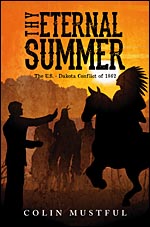Bethany Lutheran College alumnus and Minnesota author Colin Mustful recently spoke on campus about his new publication from Tate Publishing Thy Eternal Summer
– The U.S. – Dakota Conflict of 1862.
Colin Mustful is a Minnesota author and historian with an extensive background in Native American history. More specifically the author has studied the subjugation and extinguishment of the Native American as well as the reasoning and justifications for such actions by those who have sought to expel, erase, and destroy western indigenous cultures. One such work includes the author’s master’s thesis entitled, “The Generation of 1837: Attitudes, Policies, and Actions Toward Indian Populations of Argentina.” This particular work analyzes the extinguishment of Pampas Indians throughout the nineteenth century as influenced and justified through the words and works of a group of political and intellectual elite known as the Generation of 1837.
Regarding the Dakota Indians of Minnesota, the author has completed several works such as an essay entitled, “Unwarranted Expulsion: The Removal of the Winnebago Indians.” This work discusses the exile of the Winnebago Indians from the state of Minnesota as a result of the Sioux Uprising despite their very limited involvement in the conflict. The author has also completed a work titled, “A Welcome Tragedy: Factors that Led to the U.S.-Dakota Conflict of 1862” in which the author concludes that the U.S.-Dakota Conflict was the foreseeable result of years of misconduct, fraud, and exploitation which was fostered by a corrupt Indian system.
Colin Mustful resides in Minneapolis, Minnesota, who in addition graduating from Bethany, has earned a master of arts in history from Minnesota State University, Mankato. In addition to writing, Mustful is an avid soccer player and a frequent marathoner. Currently, he is working on his second historical fiction novel surrounding the events and people of the Spirit Lake Massacre of 1857, which was perpetrated by Inkpaduta and his band of renegade Wahpekute Sioux Indians.
An excerpt from the book:
“Finally, the guard called me out.
The crowd was large and boisterous, and their attention was directed solely toward me. Men and women and even some children had gathered in scores outside the courthouse…The crowd grew loud and angry. “He is a traitor!” they shouted derisively while their faces were filled with hate. “He murdered whites! He should be tortured and hanged!” I heard them continually call out. More objects came flying toward me, and I huddled low from between the guards for protection as if they were a walled fortress from which within I could hide.
Finally, I made it inside the courtroom and the door was closed behind me. On December 26, 1862, thirty-eight Sioux Indians were hanged in Mankato, Minnesota, in what remains the largest mass execution in United States history. The Indians were hanged as a result of what is known today as the U.S. – Dakota Conflict of 1862. Through the use of extensive primary source documents, Thy Eternal Summer recreates this conflict in an accurate and interesting manner. The novel centers on Alfred Riggs, a young missionary who becomes intertwined with the people, places, and events of the calamitous struggle. Throughout the conflict Alfred is continually forced to consider the perspectives of all those involved and to do what he believes is right, even at his own peril. The events and people are real and the story is largely historically accurate. Thy Eternal Summer is a compelling story of adventure, hardship, and conflict.”


